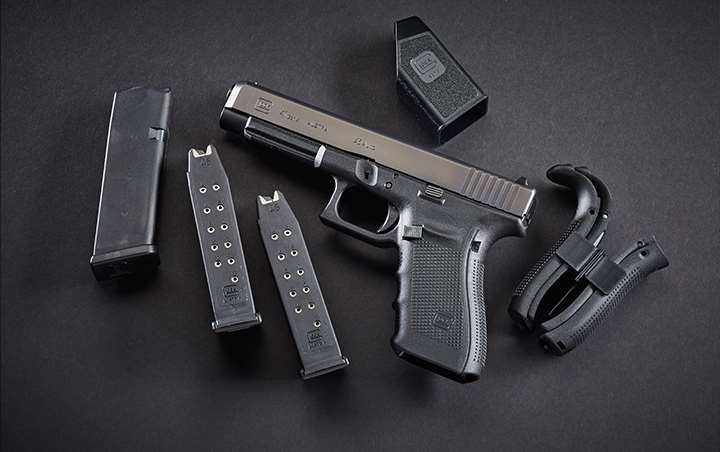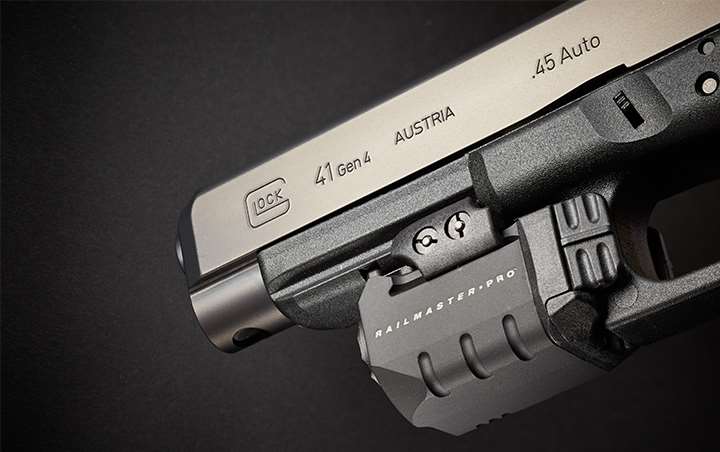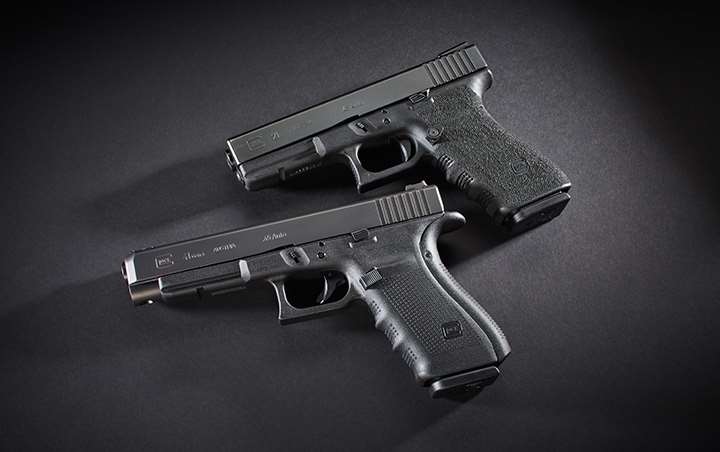
Be careful what you wish for.
In his classic horror short story “The Monkey’s Paw,” William Wymark Jacobs crafted a chilling cautionary tale of fulfilled wishes and unintended consequences. Three wishes are granted to the possessor of the grotesque but enchanted paw: While the first seems harmless enough, the last two are expended on increasingly grim and ineffective mitigation.
It gives one, er, pause. Since we’ve been wishing for a big cartridge pistol like Glock’s new G41 for a long, long time, we’re hoping the price of fulfillment is only more magazines and ammunition.
A Mash-Up
When rumors first began to circulate about the G41, we concede to having had some apprehensions. The tale that reached us through limited official hints and lots of unofficial innuendo was not altogether encouraging. A long slide .45 ACP certainly appealed, but the implications were ominous in terms of weight and maneuverability: Simply more of the famously (or infamously?) blocky and weighty front end of the company’s G21 seemed a high price to pay for welcome additional barrel length and sight radius.
While we’ve had sufficient palm/finger span for the large-frame, earlier Gen Glocks, we hoped for a short/slim frame MBS–equipped 41. This advent would make grip size a non-issue for all but very small-handed shooters. For those who like the larger grips, the 2- and 4-millimeter back straps—with or without beavertail—would also presumably be available. Other Gen4 goodies would be present as well, we hoped: The versatile dual spring recoil assembly and “rough texture” grip surface seemed optimal for taming the big Browning cartridge, and the reversible magazine release is a long-sought accommodation for left-handed operators.
Still, our fears of a “mash-up” lurked: Perhaps a well-intentioned hodgepodge of features would remain a hodgepodge, however excellent the marque?
A Marvel
We should have had more confidence. When the actual pistol emerged in January of 2014 (AW 18), not only were all the desirable Gen4 features present, but Glock engineers saw fit to marry the big dog caliber with a slimmer, longer slide. With external dimensions nearly identical to those of their most popular competitive pistol (the 9 mm G34), the new slide took more than 2 ounces off loaded weight, yet lengthened sight radius to 7.56 inches—a 12 percent increase. The nose of the pistol took on the G34/35 contour as well: A boon for re-holstering, and a contributor in weight shaving.
Close inspection revealed other changes as well. The slimming of the backstrap on all MBS frames implies the skinnier “tail” on the ejector assembly, and the G41 is no different. If you’re a current G21 owner and like to keep this sort of spare, you need a different part (Brownells 100-006-226WB).
Unlike the 34/35 long slide pistols, there is no ovoid “balancing” cut in the top, forward surface of the G41 slide. Precise management of slide dynamics is instead accomplished with internal machining. As Glock’s Ed Fitzgerald explained: “The milled slot is for weight reduction and harmonics. The slide cut on the 34/35 would have been too large, and made the slide too light.”
At The Range
In light of our mash-up apprehensions, and particularly because of the mating of the large frame with the thin-profile slide, we started at the very beginning with our G41, rounding up magazines of as many vintages as we could find. This was followed by the pillage of six counties in order to round up a sufficient bunch of "ball" ammunition.
First, we tested for correct function with every round count in the magazine, zero through 13+1. In every case, performance was flawless—smooth cycling, and slide lock on an empty magazine. We also failed to induce malfunctions with intentional limp-wristing using one hand, both strong and weak.
Next, we moved onto testing other bullet shapes. 230-grain RN had been flawless, expectedly, and 185- and 200-grain truncated cone and jacketed hollow-points from numerous manufacturers followed suit. We dragged out some target wad-cutters in different weights as well, with the same excellent results from the 1-in-15.75 twist barrel.
The need for a caution became apparent with short/radical-nosed bullets like these. Early in our tests, they proved somewhat balky while feeding. This appeared while charging the chamber from a full or nearly full magazine. During actual shooting—with the slide at operational speed—there were no failures, though a hesitation in chambering second and third rounds was sometimes perceptible. We set the remainder of these cartridges aside, returning to them after several hundred additional test rounds of other projectile types. As expected, the phenomenon had disappeared.
The explanation for this is not exactly straightforward: In a new semi-auto, recoil and magazine springs are at their maximum strengths. The recoil assembly therefore resists opening of the action to the maximum extent, while the top few rounds in the magazine are applying technically excessive frictional force to the charging “fin” on the bottom of the slide. This combination slows operational cycling slightly (causing the small hesitation we sensed while firing), but can interfere with hand cycling to the point where failures actually occur. Challenging bullet-nose shapes and atypical cartridge overall lengths exaggerate these effects on available charging force, slide velocity and bullet-nose/feed ramp collision geometry. As springs “set” to their operating range values, however, these variations moderate and problems often disappear—as they did for us.
Keep in mind, this meant our G41 was still functioning with a bullet type that simply will not work in many—even most—other pistols. For a stock defensive/duty/recreational pistol to feed them at all without modification is great testimony to the design and integration of the G41 feed ramp, chamber, magazine and recoil assembly.
Our complete rogue’s gallery of challenging bullets didn’t make it to the range for the G41 test. Experienced shooters may anticipate why, but others may not. Part of the price you pay for the spectacular barrel life of Glock factory barrels (hexagonal for most, octagonal in the case of the G41) comes with a prohibition on shooting non-jacketed bullets. No bare lead, in other words.
Given the .71-inch difference in barrel lengths between the G41 and various predecessors, we chronographed a few of our ammunition samples to see if improved velocities accrued to the longer tube. The only place a meaningful difference appeared—somewhat to our surprise—was with lighter bullets. In the G41, these truncated cones (TC) ran at 905 fps, versus 871 fps in our G21 (185 grain). Perversely, our finicky-feeding 185-grain semi-wad cutters (SWC) were just the opposite, with the shorter G21 barrel producing 39 fps more velocity (880 vs. 841). Ball ammo (230-grain RN) was right on spec: 806 fps (original Browning/Frankford Arsenal negotiated speed was 810). Velocity variation (standard deviation) was lower in our G21, but you’d expect this from a much-shot barrel: It averaged 15 fps; whereas the G41 was 41 fps on average....we were starting to feel like we could just wave that front sight at the target and initiate. Good hits seem to result almost of their own accord.
This last figure might be a worry if it hadn’t disproportionately resulted from a single projectile type, the SWC. We suspect a bore/projectile mismatch here (as opposed to a better-burnished barrel), and spent brass seemed to confirm this: More carbon on these cases indicated a less-than-ideal gas seal. A different lot from the same manufacturer, or a different manufacturer’s version of this bullet would quite likely cure these variations. Good news? In our practical tests, any accuracy fall-off was well below threshold even at surprising distance with these rounds. Such variation wouldn’t cut it in the bullseye game, perhaps, but that’s almost certainly a load issue (powder/bullet combination), not a pistol issue.
And speaking of practical exercises, this is where the G41 really shone in our view. We shot it right out of the box in a local USPSA match, and were edged out by our local PD range boss (now retired) by only 1.6 percent in L10 division—and didn’t even have to swap out our Production Division holster. We’re delighted to be within shouting distance of him anytime, but with a brand new stock pistol? Oh yeah.
We also had a green-eyed friend give us an opinion. Still serving, he has to be discrete for obvious reasons. But suffice it to say he shot all our ammunition and gave the pistol back a trifle mournfully.
In a similar vein, we couldn’t help but ponder Modular Handgun System applicability for the G41 too. Just thinkin’ out loud, mind you: But given Hague Convention limitations, .45 ACP ball could solve a lot of problems for our soldiers compared to 9 mm FMJ. As our friend good-naturedly averred: “Even the Marine Corps is ahead on this one!” (See AW 15)
Three brands of defensive ammunition were tested in the G41 as well. Felt recoil for our Winchester, Remington and Speer samples increased compared to target loads, but the difference was noticeable, not objectionable. That said, it’s not going to remind you of any 9 mm you’ve shot. Still, the characteristic .45 “slow roll” of recoil from the pistol through the wrists, forearms and shoulders—better managed, we believe, by the Gen4 compound recoil spring—meant even those thumpers remained very controllable. This combined with the longer muzzle of the G41 and kept it slightly flatter than our G21, despite its overall lighter weight.
Looking back over our fieldwork, it’s hard to overstate the benefits of the long slide on the G41. After a few hundred rounds and at targets closer than say, 15 yards, we were starting to feel like we could just wave that front sight at the target and initiate. Good hits seem to result almost of their own accord. And while not generally considered a “target” arm, there will be some Glock fans who will try it with a G41. As our experience demonstrated, the long sight radius and polygonal rifling precision may surprise not a few.
Hits at 50 yards and beyond were commonplace for all our test shooters. You can also bet there is a small but dedicated bunch of long-range/hunting pistol folks out there just about dying for a G41-like configuration in 10 mm for precisely this (excellent) reason. Along about “G44,” say?
We expect that the G41 will cut into the popularity of earlier, large-frame guns (or subtly discourage the use of backstraps), and this will be a shame. In a long teaching career, we’ve seen some surprisingly small hands adapt to the large-frame guns once proper grip architecture was demonstrated, understood and practiced. There’s a case to be made that the Glock grip angle, while less familiar and therefore less instinctively “comfortable,” is actually more ergonomically correct than shallower angles, and the benefits of the difference compound as recoil increases. More grip surface is available for absorbing recoil energy, a la the G21 and G21 SF (with backstraps), when using a two-handed grip. Downside for the G41 is that ... oh wait ... never mind. Just don’t be afraid to experiment with those backstraps: Despite the comfort of the native diameter, you may find more grip surface area than you originally guessed is what tames the potent .45 ACP best for you.
Runnin' It
There are lots of potential “homes” for the G41 outside of duty, defensive and (maybe) military use. We asked top-tier Heavy Metal Division 3-gunner Mike Payne (JP Performance Team and Rocky Mountain 3Gun “HeMan Division” champ) to give the G41 a whirl since .45 ACP lives there in .308/12-gauge land too. In the video, watch Mike get within 20/100ths of a second of his “100% Single Stack USPSA classifier” with the G41 on a steel proxy for the course of fire.”
“I’m a bit of a 1911 snob, so I was a little nervous about how I’d acclimate to the Glock platform,” Payne said. “I’ve shot them before and I have a couple, just because they always work. I really like the changes they’ve made. The controls are very ergonomic and easy to reach. The shooting characteristics of the pistol were much, much better than I was anticipating—downright excellent. Recoil management was easy; very soft. I could also get a good, high grip, and it snapped right back into the target. I was able to run it at speeds just about like my 1911, which impressed me.”
Payne added that coming from a competitive background, he thinks the G41 could find a place there.
“In the multi-gun world, we’re pretty hard on our gear, and I’d feel better about dumping this in an abandonment box,” he said. “We shot some 200 to 250 rounds today, and it was 100-percent feed reliable with two different bullet types. Overall, I was very impressed. I think it’s on my short list for future competition use.”
Gripes
We found the G41to our considerable liking in virtually every respect. But we have, shall we say, some reflections?
One is based on the expectation that a substantial percentage of G41s will make their way to competition applications, and Glock concedes this was a design criterion. In counterpoise to this are duty requirements—limitations of trigger press weight, training restrictions, types of control, etc. Glock has anticipated this with options for the G41. One includes the extended slide release lever and “light” connector, the other a standard slide catch and connector. Neither configuration is appropriate for all users, so be sure you understand differences before you settle on a particular G41.
The second relates to the structural web that has long formed the rear wall of Glock magazine wells. On small-frame guns, the web is thick enough (measured front to rear) relative to the extraction groove of .380, 9 mm and .40 cases that catching one on the other is all but impossible. But on the 41—and other large-frame pistols—it may rarely occur. The size and depth of the extraction groove on the .45 ACP case in combination with an incorrect magazine insertion angle can catch the extraction groove on this web. The result is a surprisingly hard mechanical “stop” on the reload.
Keep in mind this isn’t anything new, nor even particularly likely. A surprising number of other pistols can have reloads foiled in similar, purely mechanical ways. But if it occurs, don’t suspect there is anything wrong with your new G41, magazines or ammunition. It’s a technique issue, not a pistol problem. Hold the pistol higher as you insert the mag and “point” to that reload with the weak-hand index finger on the tip of the top round. The insertion angle problem will then take care of itself.
Final Analysis
If you visit Warrior Wars regularly, no disclosure is necessary vis-à-vis Glock products. For many reasons, we’re fans. Few lines of duty-ready pistols indeed are as affordable, reliable, maintainable and rugged, nor offer the wide range of configurations.
These characteristics combine in the G41 to enhance and extend our appreciation. As an exercise in wish fulfillment, the G41 could hardly be better, and certainly our worries about a mere mash-up of features are thoroughly, happily dashed. Over as wide a range of courses of fire as we could practically contrive, the long-slide big-bore is a winner. Time will tell the full story, but we expect to see a lot of G41s in duty rigs and in numerous competitive venues very soon—including our own.
Best of all, we expect the grip-friendly dimensions of the Glock 41 to bring—or bring back—many shooters to the .45 ACP cartridge. After well over a century of service, it remains a versatile masterpiece of cartridge design, and few platforms indeed can match the G41’s ability to access that excellence.



































